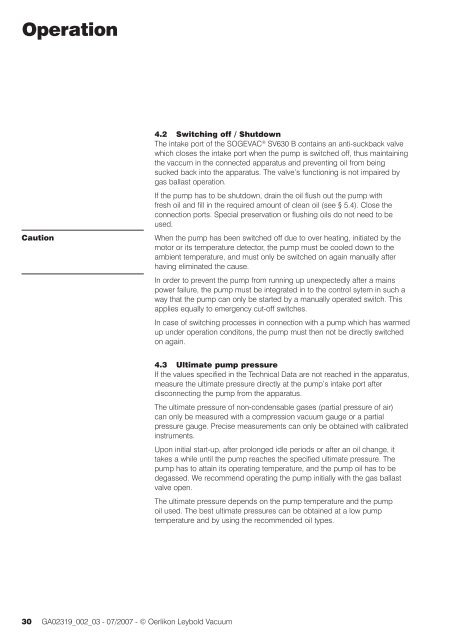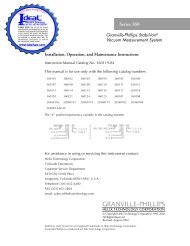Leybold, Oerlikon, Sogevac SV630 B, SV750 B, Single stage, oil ...
Leybold, Oerlikon, Sogevac SV630 B, SV750 B, Single stage, oil ...
Leybold, Oerlikon, Sogevac SV630 B, SV750 B, Single stage, oil ...
Create successful ePaper yourself
Turn your PDF publications into a flip-book with our unique Google optimized e-Paper software.
Operation<br />
Caution<br />
4.2 Switching off / Shutdown<br />
The intake port of the SOGEVAC ® <strong>SV630</strong> B contains an anti-suckback valve<br />
which closes the intake port when the pump is switched off, thus maintaining<br />
the vaccum in the connected apparatus and preventing <strong>oil</strong> from being<br />
sucked back into the apparatus. The valve’s functioning is not impaired by<br />
gas ballast operation.<br />
If the pump has to be shutdown, drain the <strong>oil</strong> flush out the pump with<br />
fresh <strong>oil</strong> and fill in the required amount of clean <strong>oil</strong> (see § 5.4). Close the<br />
connection ports. Special preservation or flushing <strong>oil</strong>s do not need to be<br />
used.<br />
When the pump has been switched off due to over heating, initiated by the<br />
motor or its temperature detector, the pump must be cooled down to the<br />
ambient temperature, and must only be switched on again manually after<br />
having eliminated the cause.<br />
In order to prevent the pump from running up unexpectedly after a mains<br />
power failure, the pump must be integrated in to the control sytem in such a<br />
way that the pump can only be started by a manually operated switch. This<br />
applies equally to emergency cut-off switches.<br />
In case of switching processes in connection with a pump which has warmed<br />
up under operation conditons, the pump must then not be directly switched<br />
on again.<br />
4.3 Ultimate pump pressure<br />
If the values specified in the Technical Data are not reached in the apparatus,<br />
measure the ultimate pressure directly at the pump’s intake port after<br />
disconnecting the pump from the apparatus.<br />
The ultimate pressure of non-condensable gases (partial pressure of air)<br />
can only be measured with a compression vacuum gauge or a partial<br />
pressure gauge. Precise measurements can only be obtained with calibrated<br />
instruments.<br />
Upon initial start-up, after prolonged idle periods or after an <strong>oil</strong> change, it<br />
takes a while until the pump reaches the specified ultimate pressure. The<br />
pump has to attain its operating temperature, and the pump <strong>oil</strong> has to be<br />
degassed. We recommend operating the pump initially with the gas ballast<br />
valve open.<br />
The ultimate pressure depends on the pump temperature and the pump<br />
<strong>oil</strong> used. The best ultimate pressures can be obtained at a low pump<br />
temperature and by using the recommended <strong>oil</strong> types.<br />
30 GA02319_002_03 - 07/2007 - © <strong>Oerlikon</strong> <strong>Leybold</strong> Vacuum

















